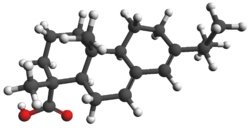Top Qs
Timeline
Chat
Perspective
Abietic acid
Chemical compound From Wikipedia, the free encyclopedia
Remove ads
Abietic acid (also known as abietinic acid or sylvic acid) is a diterpenoid found in coniferous trees. It is supposed to exist to defend the host plant from insect attack or various wounds. Chemically, it is a complicated molecule featuring two alkene groups and a carboxylic acid within a chiral tricyclic framework. As the major component of rosin, it is commercially important. Historically speaking, it was a major component of naval stores. It is the most common of the resin acids. Another common resin acid is pimaric acid, which converts to abietic acid upon heating.
Remove ads
Characteristics and occurrence
Abietic acid is found in rosin obtained from pine trees.[2] Pure abietic acid is a colorless solid, but commercial samples are usually a glassy or partly crystalline yellowish solid that melts at temperatures as low as 85 °C (185 °F).[3] Abietic acid is soluble in alcohols, acetone, and ethers. Its esters and salts are called an abietates, e.g. ethyl abietate and sodium abietate.[4]
The ancient presence of abietic acid (and other resin acids), being abundant and resilient, can inferred by analysis of rocks and archeological samples. Through the process of diagenesis, abietic acid changes into a collection of simpler compounds called abietanes.
Remove ads
Biosynthesis
Summarize
Perspective

Abietic acid is derived from the diterpene abietadiene, which in turn is made from copalyl pyrophosphate (CPP), which is derived from geranylgeranyl pyrophosphate ( GGPP), the precursor to many diterpenoids. In air and in the presence of certain cytochrome P450 enzymes, abietadiene is oxidized to abietic acid. An entire family of so-called resin acids form similarly. Together with abietic acid, these resin acids are a major portion of rosin, the solid portion of the oleoresin of coniferous trees.

The conformation of the GGPP molecule dictates the stereochemistry of the CPP intermediate after cyclization. The stereochemistry of the typical abietane skeleton suggests a GGPP precursor with its fused cyclohexyl rings in a chair-chair ("normal") conformation, although some abietanes with alternative stereochemistry may be cyclized from CCP isomers containing alternative combinations of boat and chair cyclohexane conformers. After the initial cyclization to CPP, which forms rings A and B in the abietane skeleton, the C ring is formed with the help of a class I diterpene synthase enzyme. Subsequent methyl migration and dehydrogenation steps yield the abietene isomers.[5]
Remove ads
Preparation
Abietic acid is extracted from tree rosin. Laboratory procedures illustrate the nature of the extraction, which is the basis of a substantial industry, formerly known as naval stores.[6]
Uses
As a component of rosin and one of the principal resin acids, abietic acid has many uses, e.g. in some paints, soaps, foods, soldering flux,
Safety
- As the chief component of rosin, abietic acid is approved by the US FDA as a miscellaneous food additive.[7]
- Abietic acid is considered a "nonhazardous natural substance" in tall oil ("liquid rosin").[4]
- In the U.S., abietic acid is listed in the inventory of the Toxic Substances Control Act.
- Abietic acid is the primary irritant in pine wood and resin. As a contact allergen[8] it is the cause of abietic acid dermatitis. (However, compounds resulting from its oxidation by air elicit stronger responses.) [9]
- 50% ethanol extracts from Resina pini of Pinus sp. (Pinaceae) showed inhibitory activity against testosterone 5α-reductase prepared from rat prostate. The fraction responsible for this activity was purified, and the active constituent was isolated and identified as abietic acid, which exhibited potent inhibitory activity against testosterone 5α-reductase in vitro.[10]
Remove ads
References
External links
Wikiwand - on
Seamless Wikipedia browsing. On steroids.
Remove ads




